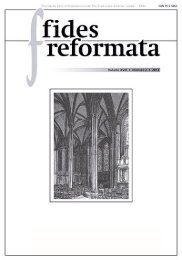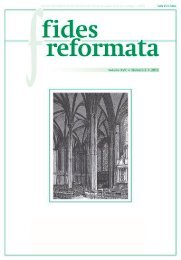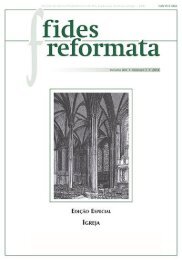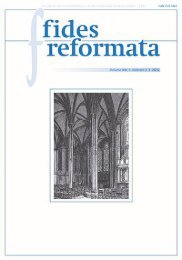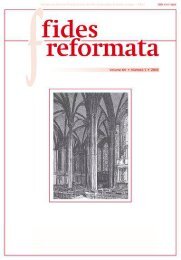Create successful ePaper yourself
Turn your PDF publications into a flip-book with our unique Google optimized e-Paper software.
FIDES REFORMATA XIX, Nº 2 (2014): 95-115<br />
1.2 We beheld his glory<br />
What exactly is meant by “glory”? Usually a reference is immediately<br />
made to 2:11, where the evangelist writes: “This, the first of his signs, Jesus<br />
did at Cana in Galilee, and manifested his glory (καὶ ἐφανέρωσεν τὴν δόξαν<br />
αὐτοῦ). And his disciples believed in him.” After that occurrence more instances<br />
follow in John’s Gospel where Jesus’ divine glory is revealed (7:39; 11:4,40;<br />
12:16,20-33,41; 13:31-32; 14:13; 15:8; 16:14; 17:5,22-24).<br />
It is not putting it too strongly to say that we now have the main theme<br />
of the Fourth Gospel. In order to see the glory of Jesus Christ one needs to be<br />
aware of what consistently comes to the fore: his unique relation with God.<br />
Jesus Christ is from heavenly descent, he is God’s own Son. However, Jesus<br />
showing his glory or the revelation of his glory is not exactly the same as<br />
what John begins to say in the prologue. Here the “we-group” is the subject:<br />
we beheld his glory (ἐθεασάμεθα τὴν δόξαν αὐτοῦ). The Son of God is seen<br />
by the eyes of those who were with him at that moment; they beheld his<br />
divine glory.<br />
It is well known that the transfiguration on the mount is not recorded<br />
in John’s Gospel. That event is described in detail in the Synoptic Gospels.<br />
A glorification of Christ would also correspond with John’s approach very<br />
well: describing Jesus’ earthly life in the light of his divine glory. So we ask:<br />
why <strong>do</strong> the Synoptic Gospels have this central instance but John <strong>do</strong>es not?<br />
The suggestion of Paul Anderson is as follows. According to 1:25 John the<br />
Baptist emphatically denies being Elijah or being “the Prophet” – that is a<br />
prophet like Moses. <strong>19</strong> The synoptic writers link both men to John the Baptist.<br />
The Fourth Gospel, however, presents Jesus as the great successor of Moses<br />
(sent by the Father) and Elijah (who did extraordinary miracles). It was truly<br />
a climactic experience in Jesus’ life on earth when those two men, Moses and<br />
Elijah, appeared on the mount of transfiguration. John, however, <strong>do</strong>es not<br />
mention this climax of his life. Instead, he demonstrates how Jesus’ whole<br />
ministry follows the line of Moses and Elijah, and by <strong>do</strong>ing so he supersedes<br />
their appearance.<br />
Anderson sees a contradiction between John and the Synoptic Gospels.<br />
This is an interesting approach, but it would be preferable to consider another<br />
solution. The phrase “we beheld his glory” can be an allusion to the transfiguration<br />
as reported in the synoptic tradition. According to the first three Gospels,<br />
John was present at that event; he was there with his brother James and also<br />
with Simon Peter. They witnessed that high point in his life on earth. However,<br />
<strong>19</strong> ANDERSON, Paul N. The Riddles of the Fourth Gospel. An Introduction to John. Minneapolis:<br />
Fortress Press, 2011, p. 209; The Fourth Gospel and the Quest for Jesus. Modern Foundations Reconsidered.<br />
Lon<strong>do</strong>n: T&T Clark, 2006, p. 156-157.<br />
101






